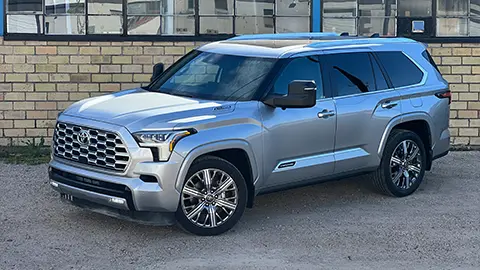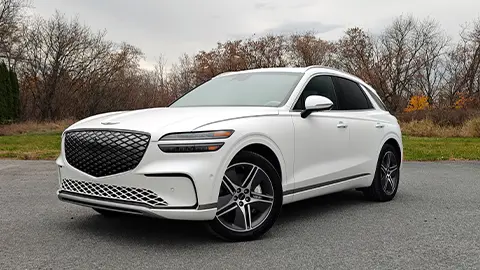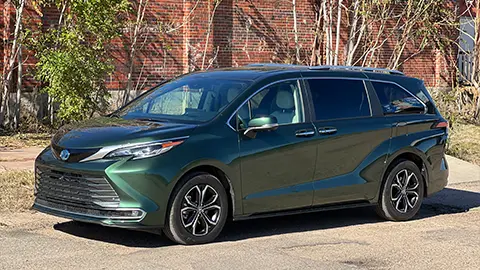2023 Nissan Leaf: First Electric Car Purchase
I never considered the pioneering Nissan Leaf a leading-edge electric vehicle – even when we dove in and actually bought one way back in 2011.
The Tesla Roadster at the time was three years into blowing away sports car fans and Italian supercars with its quiet but blistering acceleration, while built on a Lotus Elise chassis. Plus the California EV startup had already shown its futuristic Model S sedan prototype a couple years prior, which thanks to various production delays, would end up going on sale in mid-2012, roughly two years after the Leaf’s arrival to market.
Yet the Leaf was a significant vehicle in its own right. It was the first "volume" mainstream EV on sale in North America, and we appreciated that Nissan had ambitious production goals to build the compact hatchback at several plants around the world, and at much higher volumes than GM’s earlier generation two-seat EV1 or Toyota’s more practical RAV4 EV. The second-generation RAV4 EV that started its limited production around the same time as the Model S in 2012 even used similar battery technology, lending the Toyota EV an air of futuristic start-up stardust, though it was only available in California, and clearly built due to the state’s legislative arm-twisting.
In contrast, the Leaf seemed more suited to modern European or Japanese tastes, a front-wheel drive compact five-door that didn’t pretend to be a crossover or SUV, favoring efficiency and aerodynamics over power, all-wheel drive security or sprawl-out spaciousness. Those other EV rivals took astonishingly different market paths: the RAV4 EV would be discontinued by 2015, and the Tesla Model S would win an armful of awards and help change the path of EV history – or potentially overall automotive history, after its success led to higher-selling Teslas like the Model 3 and Y.
But the Model S competed with high-end luxury cars more so than the Leaf, so before the Model 3 and Y’s arrival, the mainstream Leaf was for years the best-selling EV on the planet, with plants producing it in Japan, the UK and at Nissan’s Smyrna, Tennessee plant since 2013.

Nissan Leaf: Price and Value are Best Features
This is all to provide key context of the Leaf’s rise and extended decline down the mountain of EV sales and market relevancy. But right at this moment, the hard truth for Nissan is that while it has made some key range, style and infotainment upgrades for the Leaf over its two generations, it has also not changed enough that driving the Leaf 13 years after it debuted feels way too familiar – from the driver’s seat and especially on the quick-charging info sheet.
Let’s start with the styling, which after a largely lauded redesign in 2018, looks basically the same since then, despite a mild front-end freshening that arrived here for the 2023 model. It sadly also plagued the Leaf with what could be the least attractive 17-inch black wheels on the market, which Nissan calls ‘multi-spoke’, and are thankfully optional. The Leaf’s overall design is lower and wider than its key Chevrolet Bolt rival, with no crossover pretense or the easier ingress and egress a taller body usually provides.
One key new offering on the otherwise unchanged 2024 model is the return of a federal rebate. Strangely not offered on 2023 Leaf models bought this year, the ’24 Leaf is now eligible for a partial but-still-significant $3,750 tax rebate when purchased before the end of the year. That’s when new, stricter Inflation Reduction Act (IRA) rules come in for where the sourcing of the battery materials come into effect, on top of rules implemented this year around being produced in North America and income caps to receive the federal incentive money.
Despite the Leaf being built for over a decade in the U.S., it appears that this rebate is likely to go away at the end of this calendar year, though it’s worth double-checking its latest eligibility here, as these rebates have shifted around quite a bit over the past few years.
Leasing the Leaf may be an intriguing strategy, especially for a model rumored to be either dropped or totally redesigned in 2025, as all battery-electric vehicles are currently eligible to receive the full $7,500 refund from Uncle Sam. But since the funds go directly to the financing arm that owns the vehicle (usually the finance division of the OEM, sometimes of the dealer), keep in mind that not all companies pass along the entire amount back to customers.
This federal incentive is significant because the Leaf is one of the least expensive EVs on the market, with the base Leaf S starting at $28,140 for 2024, and $36,190 for the SV Plus that comes with the larger 60 kilowatt-hour (kWh) battery. The ’23 models start at a few hundred less than that, but are not eligible for the federal tax incentive for purchasers.
Plus many states also offer tax incentives, either available at tax time, from your electric utility provider or as a point-of-sale discount at the dealer, so it’s worth looking into all those in your area. Which goes for the Leaf, or any other EV you’re considering.
A Huge Advance Over Early Models
Driving the 2023 Nissan Leaf now is like finding your former iPhone in a drawer that still charges up and still works surprisingly well, but has clearly aged compared to its newer rivals from its own company (the Nissan Ariya) and other EVs. The base Leaf S offers 149 miles of range from its 40 kWh, and while that doesn’t sound like much range, that’s more than double offered on our 24 kWh top-line Leaf back roughly a decade before.
With a lot fewer public charging stations around than now. So it is certainly doable to live with, especially if you’re using it as a runabout in the city, and you can recharge overnight in your driveway or garage.
But there are relatively few folks who want to deal with this limited of range, understandably, and only a handful of EVs that actually offer less range now. Therefore the Leaf SV Plus is available with an official range rated at 212 miles, a worthy upgrade for many for an eight-ish thousand-dollar premium.
In my week with it, this top-line Leaf indicated closer to 245 miles on its “guess-ometer” at each full charge, but that’s still an optimistic figure. In early fall 70 degree temperatures, and with roughly 80 percent urban driving, I averaged 3.49 miles per kWh, or just a little higher than its overall 31 kWh/100 miles (109 mpg-equivalent) official EPA efficiency rating.
Its Bolt nemesis beats the Leaf at both range and starting price, which is especially notable for two reasons: a) the base Bolt is roughly $10k less expensive than the Leaf SV Plus, and b) the Bolt is still eligible for a $7,500 government rebate, even if you don’t lease it. The Bolt is rated at 259 miles for the regular hatchback version, and 247 miles for the longer Bolt EUV. If simple EV range per dollar is your goal, the Bolt is tough to beat.

Interior a Roomy and Pleasant Playground
Of course, the Leaf SV Plus is much more comfortable and better equipped than a Bolt, especially a base one. The black leather and heated seats front and rear are great, with a heated steering wheel and identical computer mouse-like shifter as originally. There are both older USB-A and newer USB-C charge ports up front, and twin USB-As for rear passengers, but no wireless charging pad for your phone.
There’s still sadly no power seat adjustment for the passenger, or no power lift gate, which isn’t surprising in most compact hatchbacks, but in a vehicle this luxury vehicle-quiet, were two things noticed right away by my wife.
The Leaf’s flat bottom steering wheel helps knee room, and also on Rogue and VW ID. 4, which may technically be an EV rival, but seems a generation ahead in room and charging, but not nearly as ergonomically friendly as the Leaf. Plus the Leaf offers real AM radio, not a delay-prone digital version – or even worse, no AM radio at all.
The Leaf is classified as a Mid-size vehicle compare to the Bolt’s Small Station Wagon designation largely thanks to the Leaf’s much larger cargo area, which offers 24 cubic feet of flexibility and a handy below bumper well that means groceries placed in there won’t roll out onto the ground when you park on an inclined driveway.

Nissan Leaf: Charging Performance
On the road, the Leaf SV feels responsive to accelerator inputs in the city, thanks to its welcoming initial torque push of 250 lb-ft of torque right from launch, with the base S offering 236 lb-ft from its slightly smaller 110-kilowatt (147 hp) motor. But even the 160 kW SV with its 214 hp does feel a little pokey on the highway compared to some rivals, so plan your highway passes accordingly.
If you spend a long while on the highway, you’ll find that the Leaf’s DC quick charging painfully slow, and without liquid cooling of the battery, its thermal management system is far behind other EVs now. This results in a painfully long 45 to 60 minute estimate to charge up to 80%, and if you need another quick charge on the same trip, the battery will not have the ability to actively cool itself, and will likely be even slower to DC charge at your next rest stop as a result.
Plus keep in mind the Leaf’s DC quick charging system uses the CHAdeMO standard, not the more common CCS one that integrates the Level 2 home or standard (240-volt) charge port into the high-speed one that adds the two larger pins underneath it. There are still many CHAdeMO chargers available, and they work fairly reliably. But given that North America is moving to the Tesla-based NACS standard, and most new chargers coming onboard will offer CCS connectors and NACS connectors, the quick-charging options for Leafs seem likely to gradually diminish over the next decade. The Leaf is the only BEV left on the market to offer CHAdeMO in the U.S., and even Nissan has moved to CCS for its new Ariya, and will soon switch its connectors to NACS for its upcoming EVs.
Nissan Leaf: Final Thoughts
The Nissan Leaf is clearly then behind the times when it comes to quick charging, but as an urban runabout or second vehicle, there’s still a healthy value equation there, especially if you’re replacing a thirsty vehicle with it. And if the Chevrolet Bolt indeed leaves the market by the end of the year as GM previously announced, that will leave the Leaf as THE least expensive new highway-capable electric vehicles on sale in the U.S.
It's just not the most modern EV anymore, if it ever was.
















